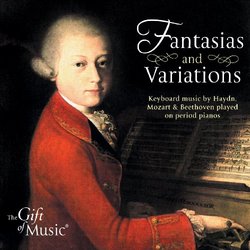| All Artists: Martin Souter Title: Fantasias & Variations Members Wishing: 0 Total Copies: 0 Label: The Gift of Music Original Release Date: 1/1/2008 Re-Release Date: 3/3/2007 Genres: New Age, Classical Styles: Instrumental, Symphonies Number of Discs: 1 SwapaCD Credits: 1 UPC: 658592119824 |
Search - Martin Souter :: Fantasias & Variations
 | Martin Souter Fantasias & Variations Genres: New Age, Classical
Fantasias & Variations Keyboard music by Haydn, Mozart and Beethoven played on period instruments. Three pianos, two from Vienna and one from London, bring to life the original sounds which these, the greatest Classica... more » |
Larger Image |
CD Details
Synopsis
Product Description
Fantasias & Variations Keyboard music by Haydn, Mozart and Beethoven played on period instruments. Three pianos, two from Vienna and one from London, bring to life the original sounds which these, the greatest Classical composers, would have known and expected to hear. Mozart is played on a Hofmann from 1790, Haydn on a Broadwood of 1801 and Beethoven on a Böhm from 1820. All three instruments are held in important museum collections and are played by Martin Souter. The instrument featured in these recordings of Mozart was made by the Viennese piano maker Ferdinand Hofmann in 1790. The Hofmann is perfectly suited to the pieces recorded here (all of which were written at around the time it was made), and it reveals an altogether more intimate and personal side to the music s character than we perceive on larger, modern instruments. Listening to these works on an instrument from Mozart s time, with its light touch, its mellow voice and bell-like upper register, brings us almost into the presence of the composer himself. We get a tantalising picture of Mozart the pianist from his letters: Unlike some, I do not grimace and roll my eyes when I play...everyone is amazed that I can always keep strict time. What these people cannot grasp is that in tempo rubato in an Adagio the left hand should go on playing in strict time. With them the left hand always follows suit ... Moreover, it is much easier to play a thing quickly than to play it slowly. In the former case certain notes can be dropped out of the runs without being missed; but is that desirable? In rapid playing the right and left hands can be changed without anyone seeing or hearing it; but is that desirable? In what then does the art of good playing consist? In this in playing the piece in correct time, as it should go, with appropriate expression and taste in every note, phrase etc., so that one would suppose the performer had composed it himself. (October 1777 & November 1778) The Haydn piano was made in London by John Broadwood in 1801, close in time to the period when Haydn was making his visits to the city. He performed at the keyboard and conducted the London orchestras, and he would have known Broadwood s instruments very well. His instruments were noted at the time for their boldness and strength. It is often said that, due to the specific English action, the pianos lacked the agility and sparkle of the Viennese instruments, but this recording actually suggests otherwise: this instrument is as bright and precise as any performer could wish, certainly in these cheerful and perky Haydn pieces. Broadwood, in fact, gave a piano to Beethoven a few years later, by which time the instruments were bigger and stronger with more substantial iron framework and bracing. Our Beethoven piano, though, is another Viennese instrument, made by Joseph Böhm in 1820. Unlike the rather plain-looking Broadwood, the Böhm piano is sumptuously decorated in gold leaf, and was obviously destined for a major patron. Napoleon s second wife, the Grand Duchess of Parma is believed to have owned the piano, which features imperial eagles on the legs and nameplates. It is brilliantly suited to middle-period Beethoven: in the score of the Moonlight sonata the composer asks for the sustaining pedal to be lifted throughout the movement, an impossibility on a modern piano, but an effect of extraordinary beauty on this instrument, especially when combined here with the true una corda of the second pedal.

 Track Listings (12) - Disc #1
Track Listings (12) - Disc #1